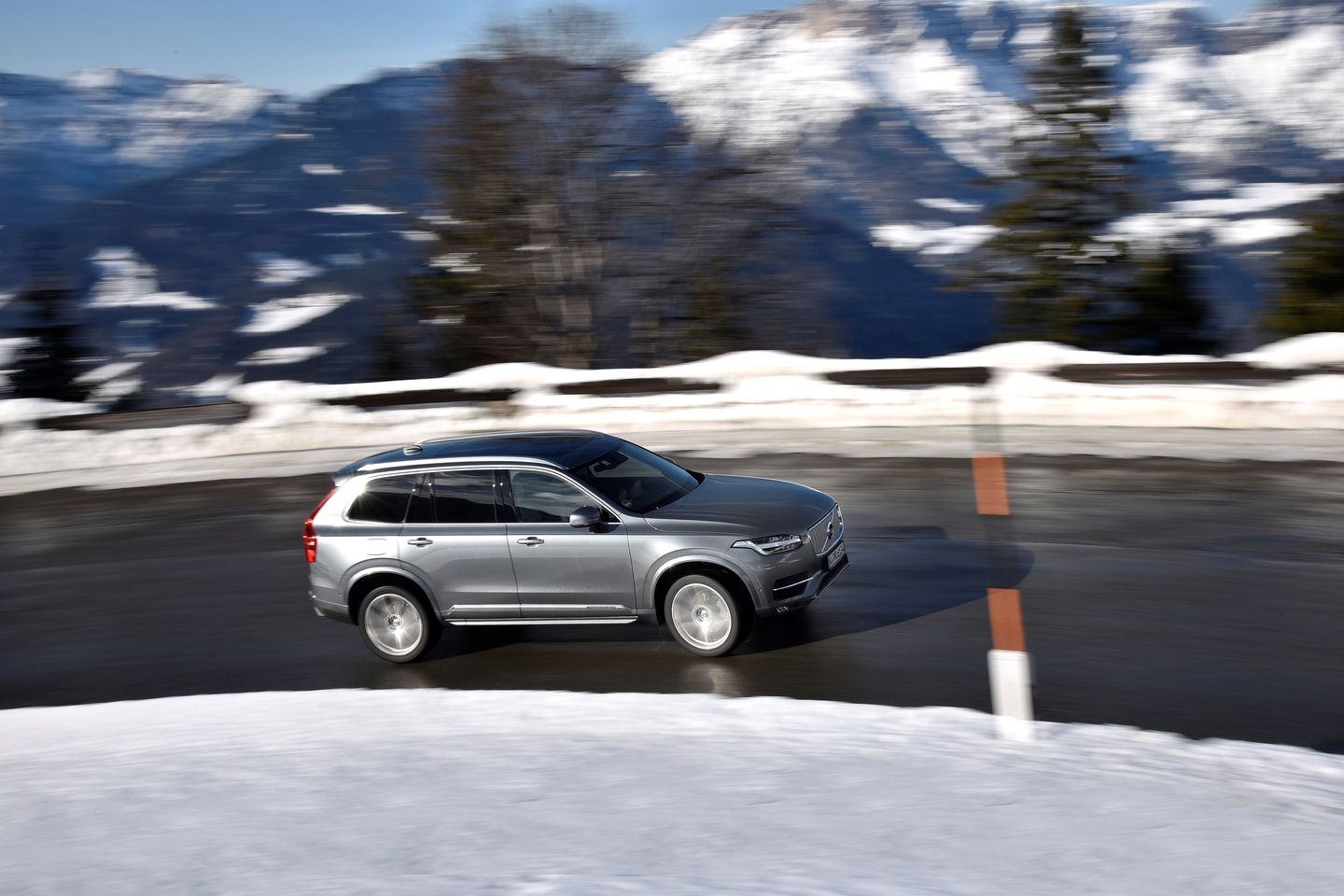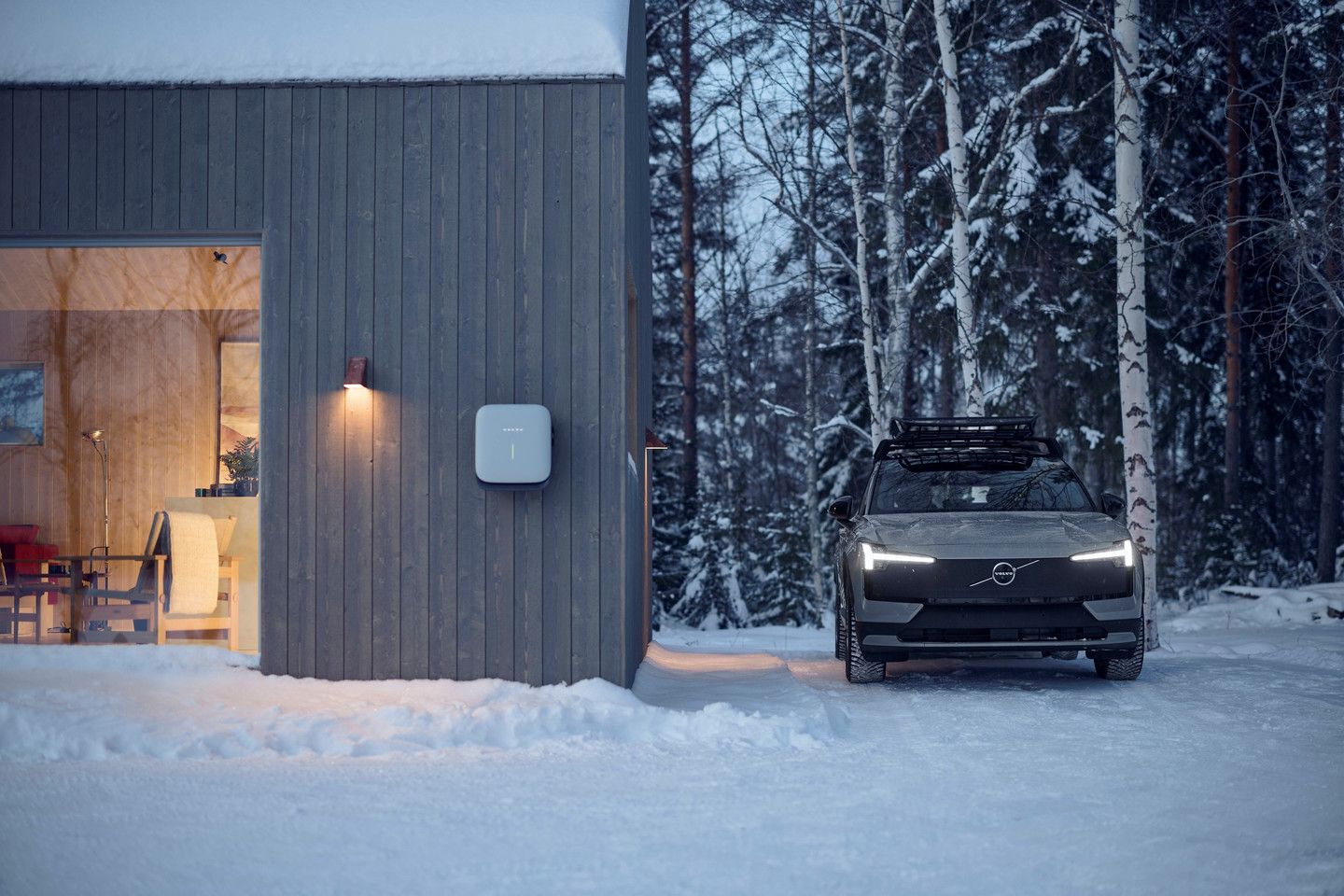
2026 Volvo EX30 Trim Levels and Pricing: Finding Your Perfect Match
The 2026 Volvo EX30 enters the Canadian market as Volvo's most accessible electric vehicle, offering premium quality in a compact package. With...
Read moreVolvo Cars Mississauga

Both the all-electric Volvo EX90 and plug-in hybrid XC90 T8 serve as flagship three-row SUVs capable of transporting six or seven passengers. Both deliver premium features, advanced safety systems, and all-wheel drive capability. However, they represent fundamentally different approaches to electrification and family transportation.
The EX90 brings next-generation technology with Google Gemini AI integration, standard LiDAR sensors, and up to 495 km of pure electric range. The XC90 T8 offers proven reliability with 455 hp combined output, 53 km of electric-only range, and unlimited gasoline backup. Understanding the practical differences between these flagship models helps Mississauga families evaluate whether the EX90's technological advancement justifies its premium, or if the XC90 T8 remains the optimal choice during the electric transition.
At a Glance: EX90 vs. XC90 T8 Key Specifications
|
Specification |
EX90 Twin Motor Performance |
XC90 T8 Plug-in Hybrid |
|---|---|---|
|
Powertrain |
Dual electric motors |
2.0 L turbo + rear electric motor |
|
Total Power Output |
510 hp |
455 hp (combined) |
|
Torque |
671 lb-ft |
523 lb-ft (combined) |
|
Electric Range |
Up to 495 km (21" wheels) |
53 km |
|
Total Range |
~495 km (charging required) |
800+ km (with full tank) |
|
Battery Capacity |
111 kWh (107 kWh usable) |
18.8 kWh (14.7 kWh usable) |
|
DC Fast Charging |
250 kW peak |
Not applicable |
|
Acceleration (0-100 km/h) |
4.9 seconds |
5.3 seconds |
|
Seating Capacity |
6 or 7 passengers |
6 or 7 passengers |
|
Cargo Volume (seats up) |
669 L (7-seat) / 662 L (6-seat) |
680 L (7-seat) |
|
Starting Price |
$110,000 (Plus trim) |
~$94,000 (Plus trim) |
Powertrain Philosophy: Pure Electric vs. Dual-Source Hybrid
The EX90 and XC90 T8 take opposing approaches to eliminating tailpipe emissions and reducing fuel consumption.
EX90's All-Electric System
The EX90 operates exclusively on battery power. Two electric motors—one producing 241 hp on the front axle, another delivering 268 hp at the rear—combine for 510 hp total output. This dual-motor configuration creates an electric all-wheel drive system with instant torque delivery and independent power management for each axle.
The 111-kWh battery pack (107 kWh usable) provides energy storage sufficient for up to 495 km of driving when equipped with 21-inch wheels. Models with 20-inch or 22-inch wheels achieve up to 476 km range.
Battery placement under the floor lowers the center of gravity while maintaining interior space. The skateboard-style battery architecture allows flat floor design throughout the cabin, maximizing passenger comfort and cargo flexibility.
Charging capability reaches 250 kW peak DC fast charging power. Under optimal conditions, the EX90 can charge from 10-80% in approximately 30 minutes using compatible high-power charging stations.
XC90 T8's Plug-in Hybrid Approach
The XC90 T8 combines a 2.0-litre turbocharged gasoline engine with a 107 kW (143 hp) electric motor. The gasoline engine drives the front wheels through an eight-speed automatic transmission, while the electric motor powers the rear axle independently.
This configuration creates a through-the-road hybrid AWD system. During electric-only operation, the rear motor propels the vehicle with front wheels freewheeling. When both power sources engage, the vehicle becomes AWD with 455 hp and 523 lb-ft of combined output.
The 18.8 kWh battery pack (14.7 kWh usable) enables 53 km of electric-only driving under typical conditions. This range covers many daily commutes and local errands without consuming gasoline. When the battery depletes, the gasoline engine takes over seamlessly, providing unlimited range limited only by the 71-litre fuel tank.
Fuel economy with a depleted battery averages 9.1 L/100 km combined. When operating in electric mode and recharging regularly, the combined rating drops to 3.8 Le/100 km equivalent.
Daily Driving Implications for Mississauga Families
The powertrain differences create distinct daily operation patterns that affect how families interact with each vehicle.
Electric-Only Operation: EX90
EX90 owners operate entirely on electricity. Every trip requires sufficient battery charge or access to charging infrastructure. This creates specific considerations:
Morning School Runs: A typical Mississauga school commute covering 15-20 km consumes roughly 3-4 kWh of battery capacity, leaving substantial range for additional errands or work commutes.
Mississauga to Downtown Toronto Commute: The approximately 30 km journey from central Mississauga to downtown Toronto uses about 6-8 kWh, well within the EX90's capacity even accounting for climate control and traffic conditions.
Weekend Activities: Trips to Heartland Town Centre, Square One Shopping Centre, or Port Credit waterfront occur entirely on electric power, with range remaining for additional stops.
Longer Trips: Travel to Niagara Falls (approximately 125 km), cottage country destinations, or visits to family in Ottawa (450 km) require route planning to identify charging stops. The EX90's 250 kW charging capability enables relatively brief stops—approximately 30 minutes adds roughly 300 km of range under optimal conditions.
Dual-Mode Operation: XC90 T8
XC90 T8 owners alternate between electric and gasoline operation based on distance and charging habits:
Daily Commuting Pattern: Drivers with sub-50 km daily routines who charge overnight complete most driving electrically. The gasoline engine remains dormant during typical weekday operation.
Extended Range Flexibility: Longer trips activate the gasoline engine automatically when battery depletes. Drivers don't modify behaviour or plan charging stops—the vehicle manages the transition transparently.
Weekend Flexibility: Friday departures for cottage weekends or family visits don't require pre-trip charging verification. Full battery provides 53 km electric operation, then gasoline extends range for the full journey.
Charging Optionality: Missing a charging session doesn't strand the vehicle. The T8 operates normally on gasoline alone, though fuel consumption increases compared to regular charging habits.
Technology and Safety: Next-Generation vs. Proven Systems
Both vehicles include comprehensive safety features and premium technology, but the EX90 introduces new systems not available in the XC90 T8.
EX90's Advanced Technology Stack
The EX90 debuts several technologies new to Volvo's lineup:
LiDAR Sensors: Standard LiDAR provides 250-metre detection range, creating a detailed three-dimensional map of the vehicle's surroundings. This sensor supplements cameras and radar to improve object detection in challenging conditions like darkness, fog, or snow.
Google Gemini AI: The EX90 becomes Volvo's first model to integrate Google Gemini artificial intelligence. This conversational AI enables natural language interaction rather than requiring specific voice commands. Drivers can speak naturally to control navigation, climate, media, and vehicle settings.
Centralized Computing: The EX90 uses a core computing platform powered by NVIDIA DRIVE AI, consolidating processing power that previous models distributed across multiple control units. This architecture enables more sophisticated features and improves over-the-air update capability.
Interior Monitoring: Cameras monitor driver alertness and can detect if occupants remain in the vehicle after parking. This system helps prevent children or pets from being accidentally left in the vehicle.
XC90 T8's Established Systems
The XC90 T8 employs proven technology refined across multiple model years:
Google Built-in: Standard integration provides Google Maps, Google Assistant, and Google Play without requiring phone connection. The system operates reliably with familiar interface design.
Pilot Assist: Adaptive cruise control with lane centering assists highway driving by maintaining speed and position within lane markings. The system operates up to 130 km/h on well-marked roads.
Comprehensive Safety Suite: Standard equipment includes collision avoidance with automatic emergency braking, blind spot monitoring with steering assistance, cross-traffic alert, lane keeping aid, and road sign recognition.
360-Degree Camera: Available camera system provides surround-view perspective to simplify parking in tight spaces common around Square One or urban Mississauga neighbourhoods.
The XC90 T8's technology delivers full functionality without introducing new systems that lack long-term reliability data. Families prioritizing proven operation over cutting-edge features may value this established approach.
Interior Space and Practicality
Both vehicles accommodate six or seven passengers depending on seating configuration, but interior dimensions differ slightly.
Passenger Space Comparison
First Row Headroom:
Second Row Legroom:
Third Row Legroom:
The EX90's additional front headroom benefits taller drivers, while the XC90 T8's extra second-row legroom provides more comfort for adult passengers in that position.
Cargo Capacity Analysis
Third Row Seats Upright:
Second and Third Rows Folded:
The EX90's flat-floor battery architecture creates more maximum cargo volume when seats fold. The XC90 T8's battery placement in the centre tunnel reduces total capacity slightly but rarely impacts practical use for family cargo needs.
Both vehicles handle typical family requirements: hockey equipment bags, grocery runs to Costco, luggage for family vacations, and furniture purchases from IKEA in Etobicoke.
Charging Infrastructure Considerations
The EX90's pure electric operation requires home charging capability and awareness of public charging networks. The XC90 T8's smaller battery and gasoline backup create different infrastructure requirements.
Home Charging Requirements
EX90:
XC90 T8:
Public Charging Networks
EX90 Public Charging:
XC90 T8 Public Charging:
Operating Cost Analysis
Total cost of ownership extends beyond purchase price to include fuel, electricity, and maintenance expenses.
Monthly Operating Costs (Based on 2,000 km Monthly Driving)
EX90 All-Electric:
XC90 T8 (With Regular Charging):
XC90 T8 (Without Regular Charging):
The EX90 provides lower operating costs for drivers with consistent charging access. The XC90 T8's costs vary significantly based on charging frequency, with disciplined charging habits delivering substantial savings versus gasoline-only operation.
Which Flagship SUV Suits Your Family's Needs?
Choose the EX90 if you:
Choose the XC90 T8 if you:
Experience Both Flagships at Volvo Cars Mississauga
The EX90 and XC90 T8 both deliver three-row luxury SUV capability through different powertrain philosophies. The EX90's pure electric operation suits families ready to transition fully to electric mobility. The XC90 T8's dual-source approach provides electric efficiency for daily driving while maintaining unlimited range for any journey.
Visit our team at Volvo Cars Mississauga to compare both flagships and determine which approach aligns with your family's driving patterns and charging access.

2026 Volvo EX30 Trim Levels and Pricing: Finding Your Perfect Match
The 2026 Volvo EX30 enters the Canadian market as Volvo's most accessible electric vehicle, offering premium quality in a compact package. With...
Read more
Winter Tire Installation for Your Volvo: Professional Service That Protects Your Investment
Most Mississauga drivers understand winter tires improve cold-weather safety and performance. The practical questions emerge after making the...
Read more
How Volvo's All-Wheel Drive Systems Manage Mississauga's Mixed Winter Surfaces
Mississauga's winter roads present a unique technical challenge for vehicle traction systems. Unlike rural areas where road conditions remain...
Read more